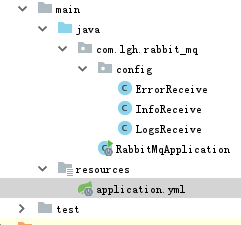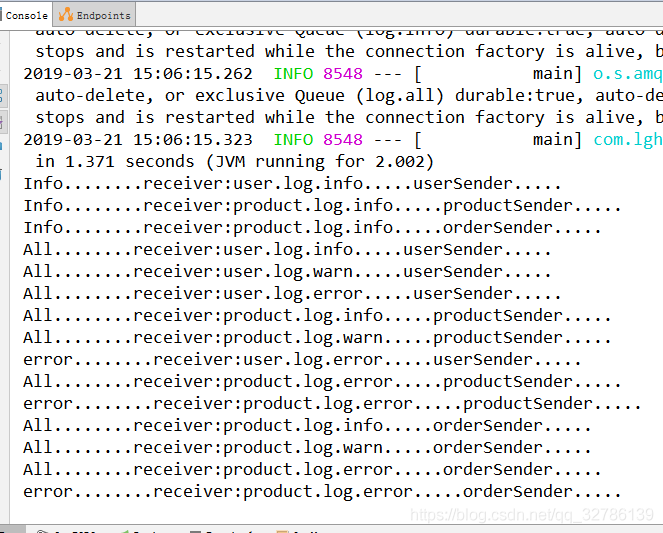RabbitMq入门(五)交换器 Topic(主题,规则匹配)
目录
首先创建两个项目
配置yml文件
编写消息接收者代码
编写消息发送者代码
测试
以此场景需求进行举例
首先创建两个项目
rabbitmq_topic_consumer 消息接收者和 rabbitmq_topic_provider消息发送者
配置yml文件
rabbitmq_topic_consumer 消息接收者
spring:
rabbitmq:
host: localhost
port: 5672
username: guest
password: guest
#设置交换器的名称
mq.config.exchange: log.topic
#info队列名称
mq.config.queue.info: log.info
#error队列名称
mq.config.queue.error: log.error
#log队列名称
mq.config.queue.logs: log.all
rabbitmq_topic_provider消息发送者
发送者只需配置发送给哪个交换器就可以了
spring:
rabbitmq:
host: localhost
port: 5672
username: guest
password: guest
#设置交换器的名称
mq.config.exchange: log.topic
编写消息接收者代码
创建三个类
*(星)可以替代一个字。
#(井号)可以替换零个或多个单词。
ErrorReceive.java
package com.lgh.rabbit_mq.config;
import org.springframework.amqp.core.ExchangeTypes;
import org.springframework.amqp.rabbit.annotation.*;
import org.springframework.stereotype.Component;
/**
* 消息接收者
* @RabbitListener bindings:绑定队列
* @QueueBinding value:绑定队列的名称
* exchange:配置交换器
*
* @Queue value:配置队列名称
* autoDelete:是否是一个可删除的临时队列
*
* @Exchange value:为交换器起个名称
* type:指定具体的交换器类型
*/
@Component
@RabbitListener(
bindings=@QueueBinding(
value=@Queue(
value="${mq.config.queue.error}",
autoDelete="true"),
exchange=@Exchange(
value="${mq.config.exchange}",
type=ExchangeTypes.TOPIC),
key="*.log.error"))
public class ErrorReceive {
@RabbitHandler
public void process(String msg) {
System.out.println("error........receiver:" + msg);
}
}
InfoReceive.java
package com.lgh.rabbit_mq.config;
import org.springframework.amqp.core.ExchangeTypes;
import org.springframework.amqp.rabbit.annotation.*;
import org.springframework.stereotype.Component;
/**
* 消息接收者
* @RabbitListener bindings:绑定队列
* @QueueBinding value:绑定队列的名称
* exchange:配置交换器
*
* @Queue value:配置队列名称
* autoDelete:是否是一个可删除的临时队列
*
* @Exchange value:为交换器起个名称
* type:指定具体的交换器类型
*/
@Component
@RabbitListener(
bindings=@QueueBinding(
value=@Queue(
value="${mq.config.queue.info}",
autoDelete="true"),
exchange=@Exchange(
value="${mq.config.exchange}",
type=ExchangeTypes.TOPIC),
key="*.log.info"))
public class InfoReceive {
@RabbitHandler
public void process(String msg) {
System.out.println("Info........receiver:" + msg);
}
}
LogsReceive.java
package com.lgh.rabbit_mq.config;
import org.springframework.amqp.core.ExchangeTypes;
import org.springframework.amqp.rabbit.annotation.*;
import org.springframework.stereotype.Component;
/**
* 消息接收者
* @RabbitListener bindings:绑定队列
* @QueueBinding value:绑定队列的名称
* exchange:配置交换器
*
* @Queue value:配置队列名称
* autoDelete:是否是一个可删除的临时队列
*
* @Exchange value:为交换器起个名称
* type:指定具体的交换器类型
*/
@Component
@RabbitListener(
bindings=@QueueBinding(
value=@Queue(
value="${mq.config.queue.logs}",
autoDelete="true"),
exchange=@Exchange(
value="${mq.config.exchange}",
type=ExchangeTypes.TOPIC),
key="*.log.*"))
public class LogsReceive {
@RabbitHandler
public void process(String msg) {
System.out.println("All........receiver:" + msg);
}
}
编写消息发送者代码
创建三个类
OrderSender.java
package com.lgh.rabbitmq.config;
import org.springframework.amqp.core.AmqpTemplate;
import org.springframework.beans.factory.annotation.Autowired;
import org.springframework.beans.factory.annotation.Value;
import org.springframework.stereotype.Component;
/**
* 消息发送者
**/
@Component
public class OrderSender {
@Autowired
private AmqpTemplate rabbitAmqpTemplate;
//exchange交换器名称
@Value("${mq.config.exchange}")
private String exchange;
/*
发送消息的方法
*/
public void send(String msg){
//向消息队列发送消息
// 参数一:交换器名称。
// 参数二:路由键
// 参数三:消息
this.rabbitAmqpTemplate.convertAndSend(this.exchange,"order. log.debug","product.log.debug....."+msg);
this.rabbitAmqpTemplate.convertAndSend(this.exchange,"order.log.info","product.log.info....."+msg);
this.rabbitAmqpTemplate.convertAndSend(this.exchange,"order.log.warn","product.log.warn....."+msg);
this.rabbitAmqpTemplate.convertAndSend(this.exchange,"order.log.error","product.log.error....."+msg);
}
}
ProductSender.java
package com.lgh.rabbitmq.config;
import org.springframework.amqp.core.AmqpTemplate;
import org.springframework.beans.factory.annotation.Autowired;
import org.springframework.beans.factory.annotation.Value;
import org.springframework.stereotype.Component;
/**
* 消息发送者
**/
@Component
public class ProductSender {
@Autowired
private AmqpTemplate rabbitAmqpTemplate;
//exchange交换器名称
@Value("${mq.config.exchange}")
private String exchange;
/*
发送消息的方法
*/
public void send(String msg){
//向消息队列发送消息
// 参数一:交换器名称。
// 参数二:路由键
// 参数三:消息
this.rabbitAmqpTemplate.convertAndSend(this.exchange,"user. log.debug","product.log.debug....."+msg);
this.rabbitAmqpTemplate.convertAndSend(this.exchange,"user.log.info","product.log.info....."+msg);
this.rabbitAmqpTemplate.convertAndSend(this.exchange,"user.log.warn","product.log.warn....."+msg);
this.rabbitAmqpTemplate.convertAndSend(this.exchange,"user.log.error","product.log.error....."+msg);
}
}
UserSender.java
package com.lgh.rabbitmq.config;
import org.springframework.amqp.core.AmqpTemplate;
import org.springframework.beans.factory.annotation.Autowired;
import org.springframework.beans.factory.annotation.Value;
import org.springframework.stereotype.Component;
/**
* 消息发送者
**/
@Component
public class UserSender {
@Autowired
private AmqpTemplate rabbitAmqpTemplate;
//exchange交换器名称
@Value("${mq.config.exchange}")
private String exchange;
/*
发送消息的方法
*/
public void send(String msg){
//向消息队列发送消息
// 参数一:交换器名称。
// 参数二:路由键
// 参数三:消息
this.rabbitAmqpTemplate.convertAndSend(this.exchange,"user. log.debug","user.log.debug....."+msg);
this.rabbitAmqpTemplate.convertAndSend(this.exchange,"user.log.info","user.log.info....."+msg);
this.rabbitAmqpTemplate.convertAndSend(this.exchange,"user.log.warn","user.log.warn....."+msg);
this.rabbitAmqpTemplate.convertAndSend(this.exchange,"user.log.error","user.log.error....."+msg);
}
}
测试
测试类
package com.lgh.rabbitmq;
import com.lgh.rabbitmq.config.OrderSender;
import com.lgh.rabbitmq.config.ProductSender;
import com.lgh.rabbitmq.config.UserSender;
import org.junit.Test;
import org.junit.runner.RunWith;
import org.springframework.beans.factory.annotation.Autowired;
import org.springframework.boot.test.context.SpringBootTest;
import org.springframework.test.context.junit4.SpringRunner;
@RunWith(SpringRunner.class)
@SpringBootTest
public class RabbitMqApplicationTests {
@Autowired
UserSender userSender;
@Autowired
ProductSender productSender;
@Autowired
OrderSender orderSender;
@Test
public void contextLoads() {
userSender.send("userSender.....");
productSender.send("productSender.....");
orderSender.send("orderSender.....");
}
}
启动接收者项目
启动测试方法
测试结果



